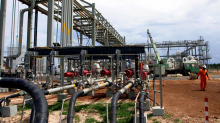Huge gas finds put east Africa on the map
 Norwegian oil company Statoil does not normally have naval patrols guarding its drilling operations. But not everywhere it operates is threatened by Somali pirates.
Norwegian oil company Statoil does not normally have naval patrols guarding its drilling operations. But not everywhere it operates is threatened by Somali pirates.Statoil set the oil industry abuzz late last month when it announced it had found huge volumes of natural gas off the coast of Tanzania, confirming east Africa’s reputation as one of the energy world’s most promising new frontiers.
The find is “fantastic,” says Tim Dodson, Statoil’s head of exploration. “Our biggest ever discovery as operator outside Norway.”
African waters can be treacherous, however. Statoil had lockdown facilities on all its rigs and support vessels to keep staff safe in the event of a pirate attack, while a small flotilla of boats, operated by security contractors and Tanzanian navy personnel, guard the drilling site.
The threat of piracy might loom large, but it has not prevented a new scramble for east Africa, led by some of the world’s biggest oil companies. Suddenly Mozambique and Tanzania, which until recently did not even feature on the world energy map, have become some of the gas industry’s hottest real estate.
The interest was underscored last month when Royal Dutch Shell and PTT Exploration, the state-controlled Thai energy group, launched rival offers for Cove Energy, a small Africa-focused oil and gas explorer with an 8.5 per cent stake in a big gas field in Mozambique. Two state-owned Indian groups, GAIL and ONGC, have also expressed an interest in bidding for Cove, although an announcement by the Mozambique authorities last week that they might impose a capital gains tax on the sale of the London-based group could deter potential bidders.
Even the threat of tax hits, however, cannot diminish the appeal of an area that has yielded a series of huge discoveries over the past couple of years, of which Cove’s field is one. “With gas exploration you have to find an elephant field to make it worthwhile,” says Simon Ashby-Rudd, an oil investment banker at Standard Bank. “They didn’t just find one elephant – they found a herd of them.”
The biggest finds were offshore Mozambique, by Anadarko Petroleum and Cove, and Eni of Italy. Their two fields combined could contain up to 60 trillion cubic feet (tcf) of recoverable resources of gas – nearly as much as Kuwait’s entire reserves. That should be enough to turn Mozambique into a key exporter of liquefied natural gas, or LNG, to China and India.
And with the region still relatively unexplored, there could be plenty more where that came from, analysts say. Less than 500 wells have been drilled in east Africa, compared with some 20,000 in the north and nearly 15,000 in the west of the continent, according to explorer Afren.
Eni’s gas discovery was “one of the most important we’ve had in our history, in terms of the quality of the reservoir, its dimensions and the markets it’s close to,” says Claudio Descalzi, chief operating officer of Eni’s exploration and production division. “It’s transformational for us.”
It could also be transformational for Mozambique. The massive LNG plant that Anadarko has proposed building there will cost around $25-billion (U.S.) – more than twice the country’s gross domestic product. The country ranks 204 out of 215 nations in terms of per capita income, according to the World Bank.
“Mozambique is one of the poorest countries in Africa, and if it gets this right, it could be one of the richest,” says at Standard Bank’s Mr. Ashby-Rudd.
Few expected a country such as Mozambique to ever become a big natural gas player. “Three years ago, when we were discussing where the future sources of LNG supply would be, east Africa wasn’t even on the list,” says Frank Harris, head of LNG at energy consultancy Wood Mackenzie.
Statoil, Shell, Petrobras and Exxon Mobil are now in Tanzania, while Eni is firmly established in Mozambique. Analysts expect others to follow as smaller players sell out, deterred by the huge expense of financing big gas liquefaction and export projects. Anadarko has already announced it is looking to sell some of its stake in the Mozambique field, and Cove put itself up for sale in January.
And as the majors pile in, the pace of drilling is picking up. Morgan Stanley expects 23 wells to be drilled off Kenya, Tanzania and Mozambique this year, almost double the number in 2011.
“Eastern sub-Saharan Africa has a lot of potential to grow quickly, and create a lot of value for us,” says Eni’s Mr. Descalzi. “It’s a very exciting moment, both for us and the countries we’re in.”
You can return to the main Market News page, or press the Back button on your browser.

